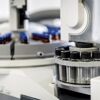If restoration cannot be commenced immediately, infested areas should be treated / disinfected temporarily without swirling any dust. It is important to observe all protective measures listed in the Bio-Substance Ordnance even for these temporary measures!
Cleaning without swirling of dust if possible
If restoration cannot be commenced immediately, infested areas should be treated / disinfected temporarily without swirling any dust. It is important to observe all protective measures listed in the Bio-Substance Ordnance even for these temporary measures!
Binding and affixing mould
Binding and affixing mould as a temporary measure, before actually undertaking mould restoration measures with the Remmers spore binder. The dust load and the mould concentration in the room air is reduced considerably. The spore binder is a special primer without solvents or plasticisers that binds mould spores and is also use to reduce mould-infested dust.
Properties:
- Complexes and binds
- Reduces the level of mould spores in the room air
- Free of solvents and plasticisers
- Can be thinned with water


Cleaning & disinfection with Mould Stop
Cleaning & disinfection of areas infested with mould temporarily with a self-acting agent like Remmers Mould Stop, if possible without swirling dust.
This is an active special cleaning agent to remove biological deposits on tiles, joints, rendering, stone, plastic, painted surfaces and other water-resistant subsurfaces.
Properties:
- Works independently
- Fast
- Solvent-free
Targeted venting & heating to reduce the growth of mould
Targeted venting & heating of mould-infested areas can reduce moisture and limit the further growth of mould.
